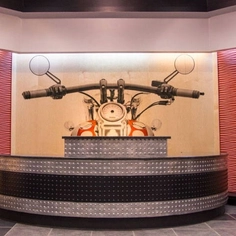Tactile Materials is an international company dedicated to the supply and production of customized metal cladding for architectural endeavors. One of the main uses for Tactile Materials is Retail Facades.
Tactile is a proactive company, working from day one to support both the aesthetic and performance aspirations of each building façade, from concept to commissioning. Ever-changing building technologies and materials require Tactile's team to be vigilant as the company develops new innovative and durable facades.
Material Applications
Tactile is a material specialist with a vast portfolio of inventive materials that cross the full spectrum of unique elements for retail façade applications. The team of engineers, architects, industrial designers, and researchers draws from both traditional façade material technologies and adaptive technologies from aerospace, automotive, and composite industries. This broader spectrum of materials gives architects and brand clients distinctive aesthetics and high-performance options that will differentiate their facades from other brands.
Concept Design
Design concepts often coalesce quickly and if the façade elements are not considered from the beginning, the façade integration can become complicated. By engaging with the design process near the same time as the structural design engineer, Tactile can support a collaborative dialog about how the façade can integrate with the structure and other important design elements. The company can also facilitate façade design charrettes with design architects, brand clients, engineers, and construction teams.
3D Modeling
Tactile utilizes a range of specialized software to capture façade structure and parametric and curvilinear surfaces. In addition to utilizing static 3D imagery, the company's team can animate complex elements to determine the theoretical movement of the façade through a variety of loads including seismic, self-weight deflections, wind, and blast resistance.
Photo-realistic Rendering
Tactile's skilled drafting teams create 3D models during the concept and/or façade charrettes to assist stakeholders in understanding the spatial, massing, and materiality of façade elements. Beyond the illustrative benefits, the larger overall façade renderings can support regulatory approvals, material selections, and budget decisions. Tactile often deploys photo-realistic rendering for recladding projects by offering before and after imagery with a myriad of options.
Finite Engineering
As optimization and technologies overlap with the finite engineering capabilities of Tactile, it has become even more relevant to validating façade design. Through hand sketches, computer models, and their team’s deep understanding of material sciences, The company is able to support innovative façade applications while mitigating the risk of material failures and diminished performance over time. With finite engineering taking place during each step of the development of façade design, common pitfalls can be avoided.
Secure Design
With the demand for more secure building environments throughout the world, Tactile's team of engineers is well-versed in providing façade protective design. Tactile evaluates the façade's role in secure design, the ability of the façade material to either absorb or resist security threats, and the serviceability of the façade over time. The team has a holistic approach to facade design, by the study of the individual façade elements and then extrapolating them to the sum of the façade performance based on the designated security level.
Thermal Modelling
Tactile thermal modeling can foretell the building enclosure's long-term thermal performance and identify possible areas of concern, ahead of the final design. Tactile utilizes advanced software and material sciences to determine the best solution for a thermally consistent building enclosure, as thermal performance is one of the most important elements to reduce building energy consumption and increase occupant comfort.
Construction Documents
The genesis of the company's construction documents begins early on during concept or schematic design. As the architect’s design evolves, Tactile's façade details, materiality, and integration with other aspects of the building take form. The building retail façade construction documents are all encompassing with detailed specifications outlining related building elements, performance criteria, materials, installation, operations, maintenance, and warranties.
Visual Mock-Ups
A key part of the retail façade aesthetic design is the creation of visual mockups that capture the architect’s visual concept. These are helpful in understanding the massing, sightlines, shadows, reflections, and opposing material finishes. It is recommended that visual mockups have interchangeable materials so the architects can experiment with varying combinations of glass, metal, earthen, and composites.
Performance Mock-Ups
The best way to validate the technical design and engineering is to conduct full-scale performance mockups in a laboratory setting. With advanced testing technologies, the test specimen can be subjected to a wide range of exposures and movements, including thermal, seismic, wind loads, dynamic water, and more. The mockup test results are further validated by the deconstruction report from the independent laboratory, noting if the mockup was constructed in compliance with the approved mockup drawings.
Façade access/BMU
When the retail facade is first studied during the concept stage, the façade access/BMU should be immediately considered. Façade access/BMU strategies are developed in response to the building massing, materials, environment, and building use. As the building enclosure evolves during the design phase and through construction documents, the façade access/BMU must be illustrated in the system drawings as well as the elevations and roof plans.
Fabrication and Assembly
Once submittal drawings have been approved, Tactile's seasoned team of production management implements the production methods to ensure that the design intent is carried throughout the production and assembly process. The façade elements are factory-finished and assembled to the greatest extent possible to minimize field fit and finish. Tactile's stringent quality control standards ensure that the retail façade comes together within tolerances to meet or exceed the branding expectations.
Install-Assist
Tactile's Project Managers are trained to rig and install façade elements worldwide. During construction planning and during the kickoff of construction, Tactile mobilizes a Project Manager to work with the client’s designated installer to address equipment requirements, sequence of construction, tolerances, integration with other trades, and the protection of the installed material during construction.

















































